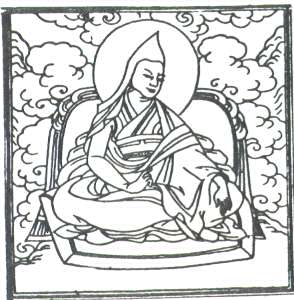Bu-ston (1290-1364)
 The great scholar and encyclopedic
writer Bu-ston is primarily associated with putting
in order the accumulation of five centuries of vast quantities of texts that had been
translated. The Buddhist centers at that time in India were largely destroyed. The
Tibetans knew extremely well what they had learned and were able to put this
knowledge to practical use regarding yoga and magic.
The great scholar and encyclopedic
writer Bu-ston is primarily associated with putting
in order the accumulation of five centuries of vast quantities of texts that had been
translated. The Buddhist centers at that time in India were largely destroyed. The
Tibetans knew extremely well what they had learned and were able to put this
knowledge to practical use regarding yoga and magic.
There were some disputes between some Orders regarding doctrine, not from doubts
or questions, but due to various Indian traditions. Also, it seemed that their thoughts
and imagination were paralysed by their faith in the word of the guru. But regarding
these people who adopted Buddhism they were unequaled in such matters.
So the complicated task of elaboration, exposition and in analysing, cataloguing was
done with consummate skill. Although much preliminary work had already been done
on systematizing the texts that were finally included in the bKa'-'gyur (Kanjur, literally
'Translation of the Buddha-Word"), Bu-ston seems to have been almost entirely
responsible for arranging the second and larger section, entitled the bsTan-'gyur
(Tenjur, literally 'Translation of the Treatises") which included all the available
translations of commentaries, exegetical literature and discourses by Indian Buddhist
scholars and yogins. Many lamas were interested in helping with funds and academic
labour, and when the work was finished the lamas of Rin-spungs and the Karma-pa
order had very fine manuscript copies prepared.
The master manuscript copies were kept at Nar-thang, where very much later, in the
eighteenth century, a printed edition was made in the traditional manner from carved
wooden blocks. Bu-ston's work was really prodigious. He wrote on 'Perfection of
Wisdom' literature and tantric texts generally with special reference to the Kalachakra
(Wheel of Time) cycle of texts, and he also wrote a history of Buddhism in India and
Tibet. Moreover, he ensured that the Tibetan versions of all texts included in the new
compiled canon were carefully checked. Where necessary, new translations were
made. This great compilation really marks the end of the labours of whole generations
of Tibetan translations.
(Ref. D. Snellgrave & H. Richardson -- A cultural history of Tibet -- p.
169-170).
Tsong Khapa had a dream of Bu-ston. In this dream Bu-ston told him to go to Lama
Chungpo Laye-pa who was of the Shangpa Kagyu lineage. When Tsong Khapa met
this Lama, he told Tsong Khapa that he also had a dream and that Bu-ston told him that
he would be coming. Lama Chungpo Laye-pa gave every teaching that he knew to
Tsong Khapa and in this way Shangpa teachings dissolved into the Gelug-pa Lineage.
Many of his works, pujas, tantras, etc.. are used by the Gelug-pa in their practice.
Bu-ston would have gained Buddhahood in his lifetime, but Pehar gave him a medicine
(bay-cho) and a pen so his time was used doing Kalachakra commentary and astrology.
He also spent much time being a doctor helping sick people.
At one time, Bu-ston's hand was ill so he asked Geshe To-may-zampo, (who wrote
"Seventy verses of Bodhisattva" and who had meditated on Bodhicitta and gained
Buddhahood), to blow on his hand to cure it. Bu-ston repaired lived at the Shalu
monastery. At this monastery, Bu-ston had a great following and he gave vows to
10,000 monks. He was 75 years old when he died on June 21 and went to Tusita.
 The great scholar and encyclopedic
writer Bu-ston is primarily associated with putting
in order the accumulation of five centuries of vast quantities of texts that had been
translated. The Buddhist centers at that time in India were largely destroyed. The
Tibetans knew extremely well what they had learned and were able to put this
knowledge to practical use regarding yoga and magic.
The great scholar and encyclopedic
writer Bu-ston is primarily associated with putting
in order the accumulation of five centuries of vast quantities of texts that had been
translated. The Buddhist centers at that time in India were largely destroyed. The
Tibetans knew extremely well what they had learned and were able to put this
knowledge to practical use regarding yoga and magic.